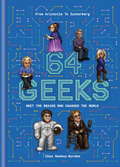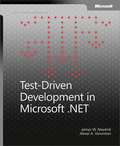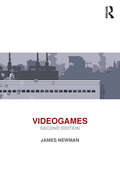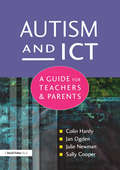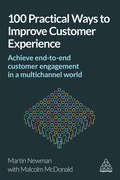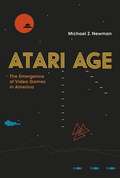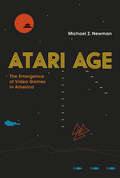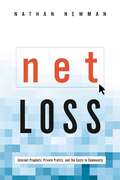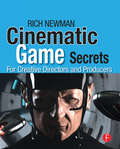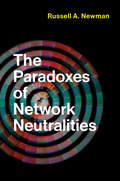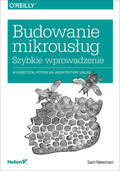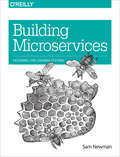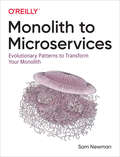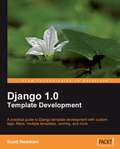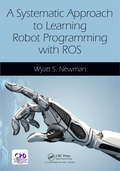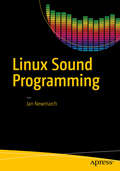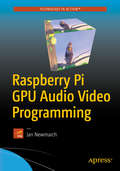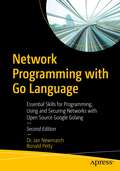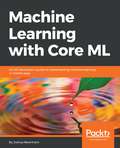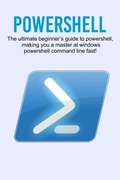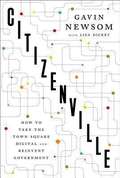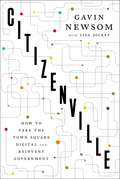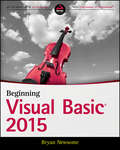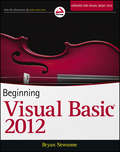- Table View
- List View
64 Geeks: The Brains Who Shaped Our World
by Chas Newkey-BurdenWe wouldn't have Bluetooth or Wi-Fi today without the ingenuity of an actress once described as "the most beautiful woman in the world."And we might have had mobile messaging as early as 1901, were it not for the fickleness of a banker. From celebrated prodigies and self-proclaimed geniuses to history's hidden heroes-64 GEEKS brings you the incredible stories of the world's best brains, all presented alongside clever 8-bit likenesses.
Test-Driven Development in Microsoft® .NET
by James W. Newkirk Alexei A. VorontsovWith the clarity and precision intrinsic to the Test-Driven Development (TDD) process itself, experts James Newkirk and Alexei Vorontsov demonstrate how to implement TDD principles and practices to drive lean, efficient coding--and better design. The best way to understand TDD is to see it in action, and Newkirk and Vorontsov walk step by step through TDD and refactoring in an n-tier, .NET-connected solution. And, as members of the development team for NUnit, a leading unit-testing framework for Microsoft .NET, the authors can offer matchless insights on testing in this environment--ultimately making their expertise your own. Test first--and drive ambiguity out of the development process: Document your code with tests, rather than paper Use test lists to generate explicit requirements and completion criteria Refactor--and improve the design of existing code Alternate programmer tests with customer tests Change how you build UI code--a thin layer on top of rigorously tested code Use tests to make small, incremental changes--and minimize the debugging process Deliver software that's verifiable, reliable, and robust
Sams Teach yourself PHP in 10 minutes
by Christopher NewmanTake your website from boring to bold and fresh with the power of php. Php is a powerful programming language specifically designed to create powerful website applications and scripts. This book has a lot to offer for both the person who has never written a line of programming code and the person who is experienced in other programming languages. Each lesson is designed to teach an important concept and is accompanied by examples and exercises to help the reader put the concepts into action.
Videogames
by James NewmanIn the few decades since they first blipped their way onto television screens, videogames have become one of the most culturally, socially and economically significant media forms. Newman’s volume considers how we might approach videogames as media texts to be read, experiences to be played and played with, systems and simulations to be decoded and interrogated, and performances to be captured, codified and preserved. The updated second edition examines the emergence of new platforms as well as changing patterns of production and consumption in its analysis of Wii, Xbox 360, PS3 and mobile gaming. The new final chapter explores recent developments in games scholarship with particular focus falling on the study of gameplay as socially situated, ‘lived experience’, and on strategies for game history, heritage and preservation. In drawing attention to the fragility and ephemerality of hardware, software and gameplay, this new edition encourages readers and players not only to consider how games might be studied but also what can, will and should be left behind for the next generation of games researchers.
Autism and ICT: A Guide for Teachers and Parents
by Julie Newman Sally Cooper Colin Hardy Jan OgdenThis book offers a practical approach for staff and carers who want to develop the use of ICT for children on the autistic spectrum and for those with language and communication difficulties. It combines descriptions of current research and literature on the subject of autism and ICT with practical guidance on software and hardware. A practical approach encourages experimentation, values the skills and attributes that participants bring and minimizes the technical barrier to ICT use. It includes concise information on what autism is, and examples of a range of pupils and their typical learning behaviors. It offers advice on how ICT can relate to various aspects of autism, information on concept keyboards and touch-sensitive screens and switches, and help with buying a computer and using the internet. Teachers, carers and parents of children with autism or language and communication problems will find lots of useful suggestions and advice on how to use ICT to help access the curriculum.
100 Practical Ways to Improve Customer Experience: Achieve End-to-End Customer Engagement in a Multichannel World
by Martin Newman Malcolm McDonaldVirtually all consumer-facing businesses talk about putting the customer first, but in reality, few deliver on this as effectively as they could. 100 Practical Ways to Improve Customer Experience walks readers through a wealth of practical tips, tools, guidelines and frameworks, for implementing customer-focused marketing strategies at every step of the customer journey. By ensuring that the customer remains the key focus, companies can identify areas in need of improvement and implement relevant steps throughout the value chain to transform their business. A unique blend of strategy and best practice, 100 Practical Ways to Improve Customer Experience has a particular focus on multi-channel industries such as retail, FMCG, travel, financial services, leisure, food and beverage, and automotive. These industries are all facing major disruption from trendsetting brands such as Uber, AirBnB and Amazon, and as such, now face more pressure than ever to adopt new practices and remain relevant in a continually competitive marketplace. Featuring case studies packed full of practical examples, this book is a unique and valuable resource for both senior industry professionals looking to transform their business and MBA students.
Atari Age: The Emergence of Video Games in America
by Michael Z. NewmanBeginning with the release of the Magnavox Odyssey and Pong in 1972, video games, whether played in arcades and taverns or in family rec rooms, became part of popular culture, like television. In fact, video games were sometimes seen as an improvement on television because they spurred participation rather than passivity. These "space-age pinball machines" gave coin-operated games a high-tech and more respectable profile. In Atari Age, Michael Newman charts the emergence of video games in America from ball-and-paddle games to hits like Space Invaders and Pac-Man, describing their relationship to other amusements and technologies and showing how they came to be identified with the middle class, youth, and masculinity.Newman shows that the "new media" of video games were understood in varied, even contradictory ways. They were family fun (but mainly for boys), better than television (but possibly harmful), and educational (but a waste of computer time). Drawing on a range of sources -- including the games and their packaging; coverage in the popular, trade, and fan press; social science research of the time; advertising and store catalogs; and representations in movies and television -- Newman describes the series of cultural contradictions through which the identity of the emerging medium worked itself out. Would video games embody middle-class respectability or suffer from the arcade's unsavory reputation? Would they foster family togetherness or allow boys to escape from domesticity? Would they make the new home computer a tool for education or just a glorified toy? Then, as now, many worried about the impact of video games on players, while others celebrated video games for familiarizing kids with technology essential for the information age.
Atari Age: The Emergence of Video Games in America
by Michael Z. NewmanThe cultural contradictions of early video games: a medium for family fun (but mainly for middle-class boys), an improvement over pinball and television (but possibly harmful) Beginning with the release of the Magnavox Odyssey and Pong in 1972, video games, whether played in arcades and taverns or in family rec rooms, became part of popular culture, like television. In fact, video games were sometimes seen as an improvement on television because they spurred participation rather than passivity. These “space-age pinball machines” gave coin-operated games a high-tech and more respectable profile. In Atari Age, Michael Newman charts the emergence of video games in America from ball-and-paddle games to hits like Space Invaders and Pac-Man, describing their relationship to other amusements and technologies and showing how they came to be identified with the middle class, youth, and masculinity.Newman shows that the “new media” of video games were understood in varied, even contradictory ways. They were family fun (but mainly for boys), better than television (but possibly harmful), and educational (but a waste of computer time). Drawing on a range of sources—including the games and their packaging; coverage in the popular, trade, and fan press; social science research of the time; advertising and store catalogs; and representations in movies and television—Newman describes the series of cultural contradictions through which the identity of the emerging medium worked itself out. Would video games embody middle-class respectability or suffer from the arcade's unsavory reputation? Would they foster family togetherness or allow boys to escape from domesticity? Would they make the new home computer a tool for education or just a glorified toy? Then, as now, many worried about the impact of video games on players, while others celebrated video games for familiarizing kids with technology essential for the information age.
Net Loss: Internet Prophets, Private Profits, and the Costs to Community
by Nathan NewmanHow has the Internet been changing our lives, and how did these changes come about? Nathan Newman seeks the answers to these questions by studying the emergence of the Internet economy in Silicon Valley and the transformation of power relations it has brought about in our new information age. Net Loss is his effort to understand why technological innovation and growth have been accompanied by increasing economic inequality and a sense of political powerlessness among large sectors of the population. Newman first tells the story of the federal government’s crucial role in the early development of the Internet, with the promotion of open computer standards and collaborative business practices that became the driving force of the Silicon Valley model. He then examines the complex dynamic of the process whereby regional economies have been changing as business alliances built around industries like the Internet replace the broader public investments that fueled regional growth in the past. A radical restructuring of once regionally focused industries like banking, electric utilities, and telephone companies is under way, with changes in federal regulation helping to undermine regional planning and the power of local community actors. The rise of global Internet commerce itself contributes to weakening the tax base of local governments, even as these governments increasingly use networked technology to market themselves and their citizens to global business, usually at the expense of all but their most elite residents. More optimistically, Newman sees an emerging countertrend of global use of the Internet by grassroots organizations, such as those in the antiglobalization movements, that may help to transcend this local powerlessness.
Cinematic Game Secrets for Creative Directors and Producers: Inspired Techniques From Industry Legends
by Rich NewmanCinematography for Games covers the space between the game and film industries by pointing out the most relevant cinematic techniques in today's hottest games, and including interviews with the game industry's greatest luminaries (including Will Wright: Sims legend, Harvey Smith, legendary game Deus Ex, Warren Spector creator of one of the original game companies, Origin).The convergence of games and film is a widely discussed and debated topic in the game industry. Many major publishers, along with some high-profile directors (John Woo, James Cameron, Steven Spielberg, Tony Scott) are exploring the middle ground between the industries. This book introduces game producers and directors to the tried and true techniques cinematographers have relied on for years.Game developers learn how to create compelling video games by: developing quality stories and characters; visualizing scenes within the game through the eyes of a cinematographer; using tried and true film industry methods for casting, voice-over, direction, and production.The book will also feature screen shots from some of today's hottest titles that illustrate key cinematic concepts, as well as advice from successful game industry professionals already using these techniques.
The Paradoxes of Network Neutralities (Information Policy)
by Russell A. NewmanAn argument that the movement for network neutrality was of a piece with its neoliberal environment, solidifying the continued existence of a commercially driven internet.Media reform activists rejoiced in 2015 when the FCC codified network neutrality, approving a set of Open Internet rules that prohibitedproviders from favoring some content and applications over others—only to have their hopes dashed two years later when the agency reversed itself. In this book, Russell Newman offers a unique perspective on these events, arguing that the movement for network neutrality was of a piece with its neoliberal environment rather than counter to it; perversely, it served to solidify the continued existence of a commercially dominant internet and even emergent modes of surveillance and platform capitalism. Going beyond the usual policy narrative of open versus closed networks, or public interest versus corporate power, Newman uses network neutrality as a lens through which to examine the ways that neoliberalism renews and reconstitutes itself, the limits of particular forms of activism, and the shaping of future regulatory processes and policies.Newman explores the debate's roots in the 1990s movement for open access, the transition to network neutrality battles in the 2000s, and the terms in which these battles were fought. By 2017, the debate had become unmoored from its own origins, and an emerging struggle against “neoliberal sincerity” points to a need to rethink activism surrounding media policy reform itself.
Budowanie mikrous?ug
by Sam NewmanWykorzystaj potencja? architektury us?ug!Architektura mikrous?ug to sposób na odej?cie od du?ych, monolitycznych aplikacji. Wyspecjalizowane us?ugi realizuj?ce konkretne zadania i komunikuj?ce si? z otoczeniem pozwalaj? na lepsze zapanowanie nad kodem, s? ?atwiejsze do przetestowania oraz bardziej elastyczne. Jednak oprócz zalet maj? te? wady. Si?gnij po t? ksi??k? i dowiedz si?, jak najlepiej radzi? sobie z architektur? mikrous?ug!Autor przedstawia w ksi??ce skuteczne techniki projektowania i korzystania z architektury mikrous?ug. W trakcie lektury kolejnych rozdzia?ów poznasz w szczegó?ach ide? mikrous?ug, korzy?ci ich stosowania, sposoby modelowania us?ug oraz skuteczne techniki dzielenia du?ej aplikacji na mikrous?ugi. Ponadto zapoznasz si? z mo?liwymi sposobami integracji: zdalne wywo?anie procedur, REST i zdarzenia — to tylko niektóre z poruszanych kwestii. Na sam koniec zaznajomisz si? z najlepszymi metodami testowania i monitorowania us?ug, zapewnisz im bezpiecze?stwo dzi?ki kluczom API oraz innym technikom. Ta ksi??ka jest obowi?zkow? lektur? dla wszystkich osób chc?cych tworzy? nowoczesne systemy bazuj?ce na architekturze mikrous?ug. Odkryj, jak mo?na dostosowa? projekt systemu do celów Twojej organizacji stosuj?c architektur? mikrous?ug Zapoznaj si? z mo?liwo?ciami integracji us?ug z pozosta?? cz??ci? systemu Zastosuj przyrostowe podej?cie do podzia?u monolitycznych baz kodu Wdra?aj pojedyncze mikrous?ugi korzystaj?c z techniki ci?g?ej integracji Zbadaj z?o?ono?? testowania i monitorowania rozproszonych us?ug Zarz?dzaj zabezpieczeniami stosuj?c modele u?ytkownik-us?uga oraz us?uga-us?uga Zapoznaj si? z wyzwaniami skalowania architektury mikrous?ugPrzekonaj si?, jak architektura mikrous?ug zmieni Twoje spojrzenie na aplikacje!Sam Newman — technolog w firmie ThoughtWorks odpowiedzialny za wspomaganie klientów oraz architektur? wewn?trznych systemów. Prelegent, autor artyku?ów dla wydawnictwa O’Reilly. Programista j?zyków Java oraz Python.
Building Microservices: Designing Fine-Grained Systems
by Sam NewmanDistributed systems have become more fine-grained in the past 10 years, shifting from code-heavy monolithic applications to smaller, self-contained microservices. But developing these systems brings its own set of headaches. With lots of examples and practical advice, this book takes a holistic view of the topics that system architects and administrators must consider when building, managing, and evolving microservice architectures.Microservice technologies are moving quickly. Author Sam Newman provides you with a firm grounding in the concepts while diving into current solutions for modeling, integrating, testing, deploying, and monitoring your own autonomous services. You'll follow a fictional company throughout the book to learn how building a microservice architecture affects a single domain.Discover how microservices allow you to align your system design with your organization's goalsLearn options for integrating a service with the rest of your systemTake an incremental approach when splitting monolithic codebasesDeploy individual microservices through continuous integrationExamine the complexities of testing and monitoring distributed servicesManage security with user-to-service and service-to-service modelsUnderstand the challenges of scaling microservice architectures
Monolith to Microservices: Evolutionary Patterns to Transform Your Monolith
by Sam NewmanHow do you detangle a monolithic system and migrate it to a microservice architecture? How do you do it while maintaining business-as-usual? As a companion to Sam Newman’s extremely popular Building Microservices, this new book details a proven method for transitioning an existing monolithic system to a microservice architecture.With many illustrative examples, insightful migration patterns, and a bevy of practical advice to transition your monolith enterprise into a microservice operation, this practical guide covers multiple scenarios and strategies for a successful migration, from initial planning all the way through application and database decomposition. You’ll learn several tried and tested patterns and techniques that you can use as you migrate your existing architecture.Ideal for organizations looking to transition to microservices, rather than rebuildHelps companies determine whether to migrate, when to migrate, and where to beginAddresses communication, integration, and the migration of legacy systemsDiscusses multiple migration patterns and where they applyProvides database migration examples, along with synchronization strategiesExplores application decomposition, including several architectural refactoring patternsDelves into details of database decomposition, including the impact of breaking referential and transactional integrity, new failure modes, and more
Django 1.0 Template Development
by Scott NewmanThis book is designed for readers who learn by doing and employs many examples and screenshots to let the reader dig in and start coding. This book isn't designed to be a reference; instead it has a practical, example-driven approach that teaches you by following along with the examples in the chapters. When you have completed this book, you will fully understand how the template system works, how to extend it when you have specialized needs, and how to optimize the performance and usability of your content. This book is for web developers and template authors who want to fully understand and utilize the Django template system. The reader should have completed the introductory tutorials on the Django project's website and some experience with the framework will be very helpful. Basic knowledge of Python and HTML is assumed.
A Systematic Approach to Learning Robot Programming with ROS
by Wyatt Newman<p>A Systematic Approach to Learning Robot Programming with ROS provides a comprehensive, introduction to the essential components of ROS through detailed explanations of simple code examples along with the corresponding theory of operation. The book explores the organization of ROS, how to understand ROS packages, how to use ROS tools, how to incorporate existing ROS packages into new applications, and how to develop new packages for robotics and automation. It also facilitates continuing education by preparing the reader to better understand the existing on-line documentation. <p>The book is organized into six parts. It begins with an introduction to ROS foundations, including writing ROS nodes and ROS tools. Messages, Classes, and Servers are also covered. The second part of the book features simulation and visualization with ROS, including coordinate transforms. <p>The next part of the book discusses perceptual processing in ROS. It includes coverage of using cameras in ROS, depth imaging and point clouds, and point cloud processing. Mobile robot control and navigation in ROS is featured in the fourth part of the book <p>The fifth section of the book contains coverage of robot arms in ROS. This section explores robot arm kinematics, arm motion planning, arm control with the Baxter Simulator, and an object-grabber package. The last part of the book focuses on system integration and higher-level control, including perception-based and mobile manipulation. <p>This accessible text includes examples throughout and C++ code examples are also provided at https://github.com/wsnewman/learning_ros</p>
Linux Sound Programming
by Jan NewmarchProgram audio and sound for Linux using this practical, how-to guide. You will learn how to use DSPs, sampled audio, MIDI, karaoke, streaming audio, and more. Linux Sound Programming takes you through the layers of complexity involved in programming the Linux sound system. You'll see the large variety of tools and approaches that apply to almost every aspect of sound. This ranges from audio codecs, to audio players, to audio support both within and outside of the Linux kernel. What You'll Learn Work with sampled audio Handle Digital Signal Processing (DSP) Gain knowledge of MIDI Build a Karaoke-like application Handle streaming audio Who This Book Is For Experienced Linux users and programmers interested in doing multimedia with Linux.
Raspberry Pi GPU Audio Video Programming
by Jan NewmarchDelve into the Broadcom VideoCore GPU used on the Raspberry Pi and master topics such as OpenGL ES and OpenMAX. Along the way, you'll also learn some Dispmanx, OpenVG, and GPGPU programming. The author, Jan Newmarch bumped into a need to do this kind of programming while trying to turn the RPi into a karaoke machine: with the CPU busting its gut rendering MIDI files, there was nothing left for showing images such as karaoke lyrics except for the GPU, and nothing really to tell him how to do it. Raspberry Pi GPU Audio Video Programming scratches his itch and since he had to learn a lot about RPi GPU programming, he might as well share it with you. What started as a side issue turned into a full-blown project of its own; and this stuff is hard. What You'll Learn Use Dispmanx and EGL on Raspberry Pi Work with OpenMAX and its components, state, IL Client Library, * * Buffers, and more on RPi Process images and video on RPi Handle audio on RPi Render OpenMAX to OpenGL on the RPi Play multimedia files on the RPi Use OpenVG for text processing and more Master overlays Who This Book Is For You should be comfortable with C programming and at least some concurrency and thread programming using it. This book is for experienced programmers who are new or learning about Raspberry Pi.
Network Programming with Go Language: Essential Skills for Programming, Using and Securing Networks with Open Source Google Golang
by Jan Newmarch Ronald PettyDive into key topics in network architecture implemented with the Google-backed open source Go programming language. Networking topics such as data serialization, application level protocols, character sets and encodings are discussed and demonstrated in Go. This book has been updated to the Go version 1.18 which includes modules, generics, and fuzzing along with updated and additional examples. Beyond the fundamentals, Network Programming with Go, Second Edition covers key networking and security issues such as HTTP protocol changes, validation and templates, remote procedure call (RPC) and REST comparison, and more. Additionally, authors Ronald Petty and Jan Newmarch guide you in building and connecting to a complete web server based on Go. Along the way, use of a Go web toolkit (Gorilla) will be employed. This book can serve as both an essential learning guide and reference on networking concepts and implementation in Go. Free source code is available on Github for this book under Creative Commons open source license.What You Will Learn Perform network programming with Go (including JSON and RPC) Understand Gorilla, the Golang web toolkit, and how to use it Implement a microservice architecture with Go Leverage Go features such as generics, fuzzing Master syscalls and how to employ them with Go Who This Book Is For Anyone interested in learning networking concepts implemented in modern Go. Basic knowledge in Go is assumed, however, the content and examples in this book are approachable with modest development experience in other languages.
Machine Learning with Core ML: An iOS developer's guide to implementing machine learning in mobile apps
by Joshua NewnhamLeverage the power of Apple's Core ML to create smart iOS appsKey Features Explore the concepts of machine learning and Apple’s Core ML APIs Use Core ML to understand and transform images and videos Exploit the power of using CNN and RNN in iOS applicationsBook DescriptionCore ML is a popular framework by Apple, with APIs designed to support various machine learning tasks. It allows you to train your machine learning models and then integrate them into your iOS apps.Machine Learning with Core ML is a fun and practical guide that not only demystifies Core ML but also sheds light on machine learning. In this book, you’ll walk through realistic and interesting examples of machine learning in the context of mobile platforms (specifically iOS). You’ll learn to implement Core ML for visual-based applications using the principles of transfer learning and neural networks. Having got to grips with the basics, you’ll discover a series of seven examples, each providing a new use-case that uncovers how machine learning can be applied along with the related concepts. By the end of the book, you will have the skills required to put machine learning to work in their own applications, using the Core ML APIsWhat you will learnUnderstand components of an ML project using algorithms, problems, and dataMaster Core ML by obtaining and importing machine learning model, and generate classesPrepare data for machine learning model and interpret results for optimized solutionsCreate and optimize custom layers for unsupported layers Apply CoreML to image and video data using CNNLearn the qualities of RNN to recognize sketches, and augment drawingUse Core ML transfer learning to execute style transfer on imagesWho this book is forMachine Learning with Core ML is for you if you are an intermediate iOS developer interested in applying machine learning to your mobile apps. This book is also for those who are machine learning developers or deep learning practitioners who want to bring the power of neural networks in their iOS apps. Some exposure to machine learning concepts would be beneficial but not essential, as this book acts as a launchpad into the world of machine learning for developers.
Powershell: The ultimate beginner's guide to Powershell, making you a master at Windows Powershell command line fast
by Newport CraigThis book covers the topic of Windows PowerShell and will teach you all about how to use it and all of its possibilities. <P><P>Essentially, the PowerShell is a command line interface that operates within the Windows system, with the purpose of task automation and configuration management. It is a fairly intuitive system, and as you will soon realize, it doesn’t take too long to get the hang of! <P><P>Inside, you will learn how the PowerShell operates, how the associated scripting language works, the different commands you will need to know, and what kind of things are possible when using the PowerShell. <P><P>Even if you’re totally new to programming and have never used a scripting environment, at the completion of this book you should have a solid understanding of Windows PowerShell, and be ready to get started!
Citizenville
by Gavin Newsom"Citizenville offers both an impassioned plea for more tech-enabled government and a tour d'horizon of the ways some governments have begun using technology to good effect... a fast-paced and engaging read” --San Francisco Chronicle A rallying cry for revolutionizing democracy in the digital age, Citizenville reveals how ordinary Americans can reshape their government for the better. Gavin Newsom, the lieutenant governor of California, argues that today’s government is stuck in the last century while-in both the private sector and our personal lives-absolutely everything else has changed. The explosion of social media, the evolution of Internet commerce, the ubiquity of smart phones that can access all the world’s information; in the face of these extraordinary advances, our government appears increasingly irrelevant and out of touch. Drawing on wide-ranging interviews with thinkers and politicians, Newsom’s Citizenville shows how Americans can transform their government, taking matters into their own hands to dissolve political gridlock even as they produce tangible changes in the real world. When local Web designers wanted to prevent muggings in Chicago and Oakland, they created innovative crime-mapping tools using public police data. When congressional representatives wanted citizens’ input on new legislation, they used interactive blogging tools to invite public comments and changes. When a town in Texas needed to drum up civic engagement, officials invented a local digital "currency” to reward citizens for participating in government-making small-town politics suddenly as fun and addictive as online games such as Farmville. Surveying the countless small advances made by ordinary Americans in reinventing government for the twenty-first century, Newsom unveils a path for American prosperity and democratic vitality. Newsom explains how twenty-first-century problems are too big and too expensive for the government simply to buy solutions; instead, Americans must innovate their way out. Just as the post office and the highway system provide public infrastructure to channel both personal and private enterprise-a platform upon which citizens can grow-so too could a modern digital government house the needs, concerns, information, and collaboration of an enlightened digital citizenry. A vision for better government that truly achieves the ancient goal of commonwealth and a triumphant call for individuals to reinvigorate the country with their own two hands, Citizenville is a timely road map for restoring American prosperity and for reinventing citizenship in today’s networked age. .
Citizenville: How to Take the Town Square Digital and Reinvent Government
by Gavin Newsom Lisa Dickey"Citizenville offers both an impassioned plea for more tech-enabled government and a tour d'horizon of the ways some governments have begun using technology to good effect. . . a fast-paced and engaging read" --San Francisco Chronicle A rallying cry for revolutionizing democracy in the digital age, Citizenville reveals how ordinary Americans can reshape their government for the better. Gavin Newsom, the lieutenant governor of California, argues that today's government is stuck in the last century while--in both the private sector and our personal lives--absolutely everything else has changed. The explosion of social media, the evolution of Internet commerce, the ubiquity of smart phones that can access all the world's information; in the face of these extraordinary advances, our government appears increasingly irrelevant and out of touch. Drawing on wide-ranging interviews with thinkers and politicians, Newsom's Citizenville shows how Americans can transform their government, taking matters into their own hands to dissolve political gridlock even as they produce tangible changes in the real world. When local Web designers wanted to prevent muggings in Chicago and Oakland, they created innovative crime-mapping tools using public police data. When congressional representatives wanted citizens' input on new legislation, they used interactive blogging tools to invite public comments and changes. When a town in Texas needed to drum up civic engagement, officials invented a local digital "currency" to reward citizens for participating in government--making small-town politics suddenly as fun and addictive as online games such as Farmville. Surveying the countless small advances made by ordinary Americans in reinventing government for the twenty-first century, Newsom unveils a path for American prosperity and democratic vitality. Newsom explains how twenty-first-century problems are too big and too expensive for the government simply to buy solutions; instead, Americans must innovate their way out. Just as the post office and the highway system provide public infrastructure to channel both personal and private enterprise--a platform upon which citizens can grow--so too could a modern digital government house the needs, concerns, information, and collaboration of an enlightened digital citizenry. A vision for better government that truly achieves the ancient goal of commonwealth and a triumphant call for individuals to reinvigorate the country with their own two hands, Citizenville is a timely road map for restoring American prosperity and for reinventing citizenship in today's networked age.
Beginning Visual Basic 2012
by Bryan NewsomeThe ultimate beginner's guide to programming in Visual Basic 2012 Visual Basic, used to write Windows applications and web apps with ASP. NET, is an essential language for beginning programmers. Using the time-tested Wrox approach, this guide provides a step-by-step format that gets beginners up and running quickly and confidently. Essential topics covered include writing Windows applications, working with dialog boxes and menus, object oriented programming techniques, programming for graphics, using Visual Basic with ASP. NET for web apps, and dealing with data access and SQL Server. Visual Basic is a popular first language for beginning programmers; this Wrox beginner's guide covers all aspects of the newest version Uses a basic, step-by-step approach to help beginners learn quickly and easily Covers essential topics including flow control, data structure, writing Windows applications, error handling and debugging, objects and object oriented techniques, and class libraries Explains Windows Forms, graphics programming, accessing databases, web programming using Visual Basic with ASP. NET, data access, SQL Server, ADO. NET, and XML Beginning Visual Basic 2012 is a must-have for programming newcomers who want to get a solid footing in one of the most important programming languages.
Beginning Visual Basic 2012
by Bryan NewsomeThe ultimate beginner's guide to programming in Visual Basic 2012 Visual Basic, used to write Windows applications and web apps with ASP.NET, is an essential language for beginning programmers. Using the time-tested Wrox approach, this guide provides a step-by-step format that gets beginners up and running quickly and confidently. Essential topics covered include writing Windows applications, working with dialog boxes and menus, object oriented programming techniques, programming for graphics, using Visual Basic with ASP.NET for web apps, and dealing with data access and SQL Server. Visual Basic is a popular first language for beginning programmers; this Wrox beginner's guide covers all aspects of the newest version Uses a basic, step-by-step approach to help beginners learn quickly and easily Covers essential topics including flow control, data structure, writing Windows applications, error handling and debugging, objects and object oriented techniques, and class libraries Explains Windows Forms, graphics programming, accessing databases, web programming using Visual Basic with ASP.NET, data access, SQL Server, ADO.NET, and XML Beginning Visual Basic 2012 is a must-have for programming newcomers who want to get a solid footing in one of the most important programming languages.
